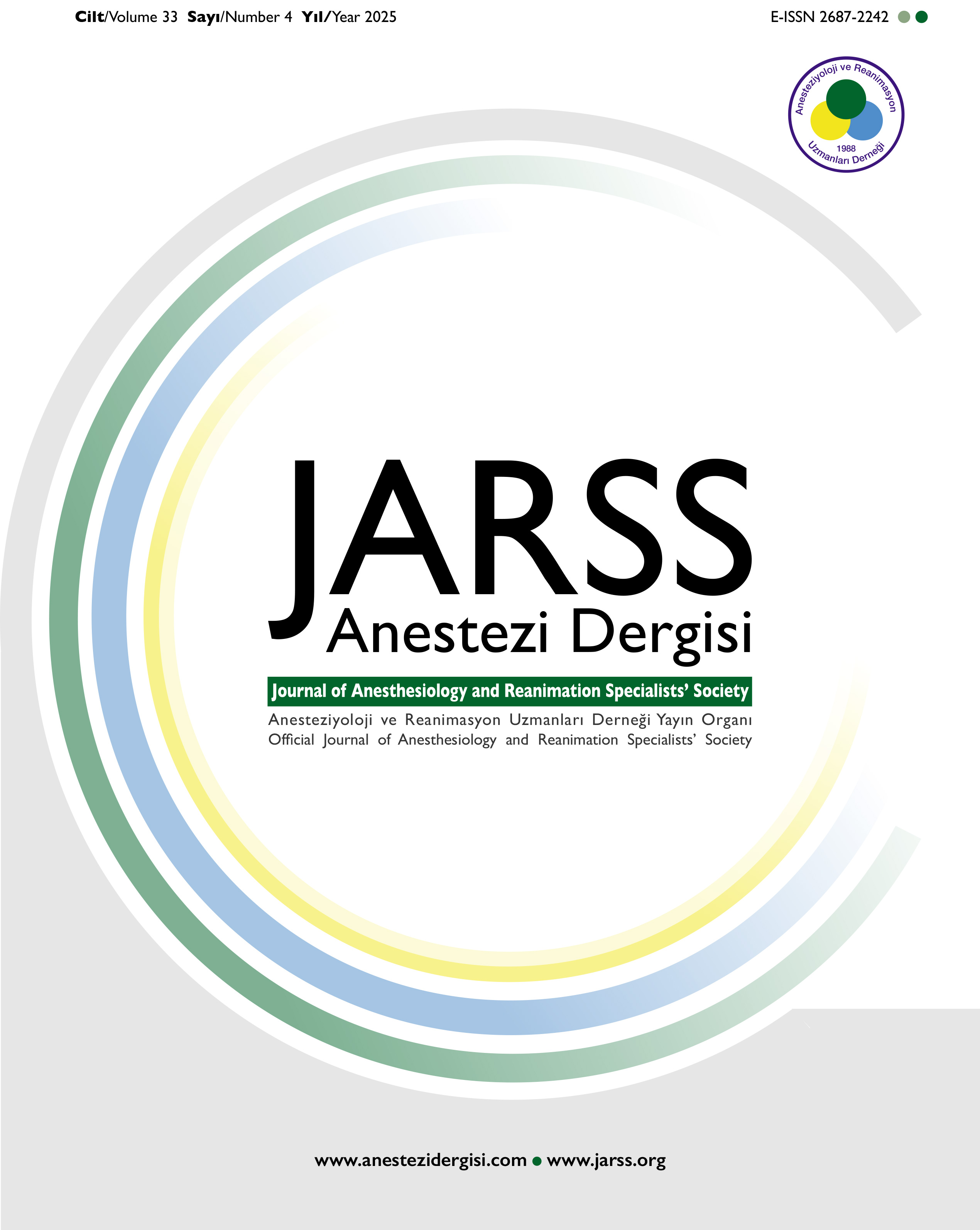Kaf İçi ve Dışına Lidokain Uygulamasının Ekstübasyon Sonrası Görülen Kardiyovasküler ve Solunum Sistemi Yanıtlarına Etkileri
Selin Eyüpoğlu1, İrfan Güngör2, Kadir Kaya21Ordu Devlet Hastanesi, Anesteziyoloji ve Reanimasyon Kliniği, Ordu, Türkiye2Gazi Üniversitesi Tıp Fakültesi, Anesteziyoloji ve Reanimasyon Ana Bilim Dalı, Ankara, Türkiye
Amaç: Araştırmamızda, entübasyon öncesinde endotrakeal tüp kafı (ETTK) etrafına lidokain sprey uygulamasının ve entübasyon sonrasında kaf içinde lidokain kullanımının etkinliğinin değerlendirilmesi amaçlandı. Birincil hedefimiz, ekstübasyon aşamasına kadar kardiyovasküler ve solunum sistemleri üzerinde ortaya çıkan etkilerin incelenmesi olarak belirlendi.
Yöntem: Jinekolojik operasyon planlanan, ASA I-II, 18-65 yaş arası ve bir saatten uzun süren genel anestezi uygulanacak 200 hasta çalışmaya alındı; hastalar rastgele 4 eşit gruba ayrıldı. Grup I’de entübasyonu takiben ETTK hava ile şişirilirken, Grup II’de entübasyondan önce ETTK etrafına %10 lidokain püskürtüldü. Grup III’te entübasyondan sonra ETTK %2 lidokain ile şişirilirken, Grup IV’te entübasyon öncesi ETTK etrafına %10 lidokain sprey püskürtülüp, tüp kafı da %2 lidokain ile şişirildi. Ekstübasyon sonrası erken dönemdeki kardiyovasküler parametreler ve postoperatif boğaz ağrısı, öksürük ve ses kısıklığı vakaları operasyon sonrası 48 saate kadar kaydedildi.
Bulgular: Kardiyovasküler sistem parametrelerinde ekstübasyondan sonra tüm gruplarda 5-15 dakika süren artış gözlendi. Postoperatif boğaz ağrısı, öksürük ve ses kısıklığı verileri tüm gruplarda benzerdi.
Sonuç: Çalışma, ETTK etrafına %10 lidokain sprey uygulanmasının yanı sıra kafın içinde tek başına veya birlikte %2 lidokain kullanımının, ekstübasyon sonrası erken dönemde kardiyovasküler sistem yanıtlarında bir azalmaya yol açmadığını ortaya koymuştur. Ancak, bu müdahaleler postoperatif solunum sistemi yan etkilerinde azalmaya yol açmış olsa da, bu tür olayların tamamen önlenmesini sağlamamıştır.
Anahtar Kelimeler: Lidokain, endotrakeal tüp kafı, ekstübasyon, hemodinamik, pulmoner
Effects of Lidocaine Application Intracuff and Around the Cuff on Cardiovascular and Respiratory Responses to Extubation
Selin Eyüpoğlu1, İrfan Güngör2, Kadir Kaya21Ordu State Hospital, Department of Anesthesiology and Reanimation, Ordu, Türkiye2Gazi University Faculty of Medicine, Department of Anesthesiology and Reanimation, Ankara, Türkiye
Objective: In our investigation, we aimed to assess the efficacy of employing lidocaine spray application around endotracheal tube cuff (ETTC) prior to intubation, alongside and the use of intracuff lidocaine application following intubation. Our primary objective encompassed an examination of the resultant effects on the cardiovascular and respiratory systems leading up to the extubation phase.
Methods: Two hundred patients scheduled for gynecologic operations, with an ASA physical status of I or II and aged between 18 and 65 years, undergoing general anesthesia lasting over one hour, were recruited for the study. Patients were allocated into four groups. Group I involved the inflation of the endotracheal tube cuff with air following intubation. In Group II, 10% lidocaine was sprayed around the ETTC prior to intubation. Group III entailed the inflation of the ETTC with 2% lidocaine after intubation. Lastly, Group IV received both the pre-intubation application of 10% lidocaine spray around the ETTC and the inflation of the cuff with 2% lidocaine following intubation. Cardiovascular parameters in the early post-extubation period and occurrences of postoperative sore throat, cough, and hoarseness up to 48 hours post-operation were documented for analysis.
Results: Increases were observed at cardiovasvular system parameters after extubation in all groups continued for 5 or 15 minutes. Postoperative data for sore throat, cough and hoarseness
were smilar in all groups.
Conclusion: The study revealed that the administration of 10% lidocaine spray around the ETTC, as well as the use of 2% lidocaine within the cuff alone or in combination, did not result in a reduction of cardiovascular system responses during the early post-extubation period. However, these interventions did lead to a decrease in postoperative respiratory system side effects, albeit not providing complete prevention of such occurrences.
Keywords: Lidocaine, endotracheal tube cuff, extubation, hemodynamic, pulmonary
Makale Dili: Türkçe
(415 kere indirildi)












